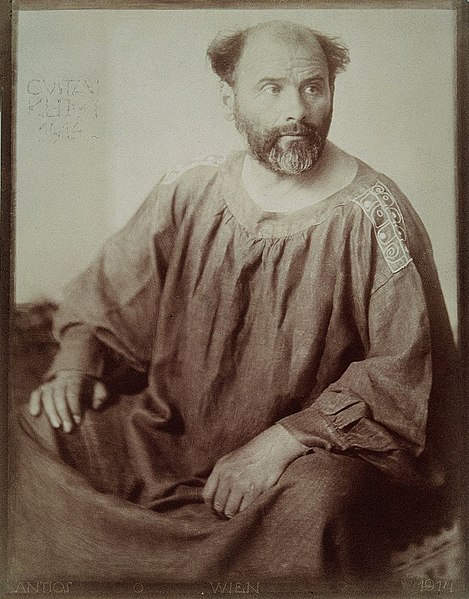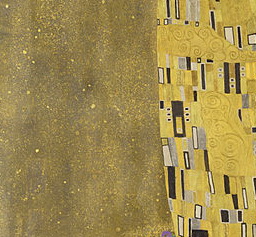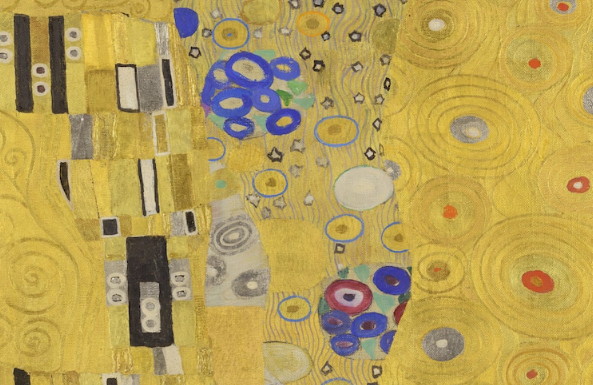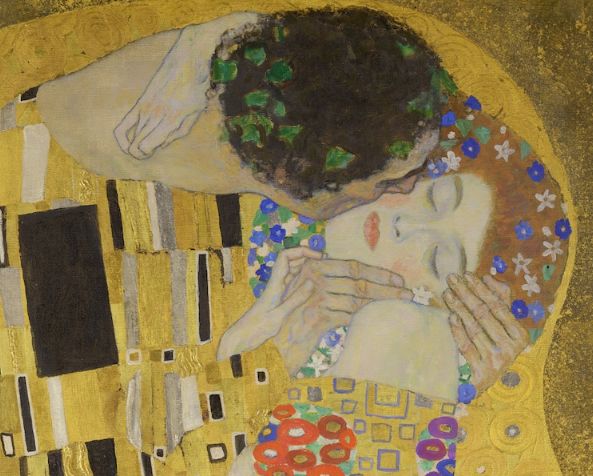Gustav Klimt's "The Kiss": A Symphony of Color, Gold, and Love
Gustav Klimt (1862–1918) stands as a towering figure in Austrian art, renowned for his pivotal role in the turn-of-the-century art scene, particularly through his contributions to Symbolism and Art Nouveau. Born in Baumgarten, near Vienna, Klimt emerged from the academic tradition to become a leader in the Vienna Secession, a movement that sought to challenge the conservative constraints of the Vienna Künstlerhaus. His work is characterized by an eclectic blend of styles, drawing from classical, Byzantine, Egyptian, and Japanese influences to create a unique visual language that was both avant-garde and deeply personal.

Photograph By Gustav Klimt, 1914
Klimt's artistic journey is often divided into several phases, with his "Golden Phase" being the most celebrated. During this period, he incorporated gold leaf into his paintings, creating luxuriant surfaces that shimmer with a mystical quality. This technique is epitomized in his iconic work, "The Kiss" (1907-1908), where the ethereal use of gold adds a divine quality to the intimate scene depicted. Klimt's art is marked by a focus on female sensuality, ornate patterns, and bold use of color, themes that align with the Symbolist movement's interest in the emotional and the mystical.

Gustav Klimt "The Kiss" (1907-1908)
Beyond his famed figurative works, Klimt also explored landscapes, displaying a softer, yet equally innovative approach. These paintings, often overlooked, showcase his sensitivity to nature's beauty and his skill in capturing the ephemeral. Throughout his career, Klimt's work was both celebrated and controversial, embodying the tension between traditional and modernist impulses that defined the era. Today, his legacy is that of an artist who dared to envision a new aesthetic, blending the decorative with the deeply symbolic, and in doing so, forever altered the course of European art.
In this article, we will delve deeper into Gustav Klimt's masterpiece "The Kiss," exploring the intricate details, symbolic significance, and enduring legacy of this iconic painting.
What Makes Klimt's Style Distinctive?
Firstly, his pioneering use of gold leaf in the "Golden Phase" introduced a luxurious, ethereal quality rarely seen in such scale and intensity in Western art since the Byzantine era. This technique not only elevated the aesthetic appeal of his works but also imbued them with a divine, timeless essence.

Klimt's art represents a bold departure from the prevailing styles, influenced by a fascination with Byzantine, ancient Egyptian, and Asian art, as well as a keen interest in contemporary scientific and psychological theories. His pioneering spirit not only defined the Vienna Secession but also left an indelible mark on the trajectory of modern art, making his work a critical study for understanding the evolution of artistic expression at the turn of the century.
Klimt's thematic exploration was another aspect of his uniqueness. He delved into subjects of love, sexuality, and existential contemplation, often intertwining them with complex symbolism drawn from mythology, psychology, and dreams. This was a bold move away from the more conservative themes prevalent among his contemporaries, making his work resonate with a modern audience's concerns and fascinations.
The Uniqueness of "The Kiss"
The painting stands as one of the most emblematic and celebrated works of the early 20th century, marking the pinnacle of the artist's Golden Phase. This period is distinguished by Klimt's lavish use of gold leaf, which imbues his works with a radiant, transcendental quality, and "The Kiss" is perhaps the most exquisite example of this technique. The painting captures an intimate moment between two lovers, enveloped in an ornate cloak that blends seamlessly into the golden, flower-strewn background, blurring the boundaries between the figures and their surroundings.
"The Kiss" is painted in a style that synthesizes elements of Symbolism and Art Nouveau, with Klimt drawing on Byzantine, classical, and contemporary influences to create a composition that is both timeless and distinctly modern. The use of gold leaf not only references the sacred art of Byzantine mosaics but also adds a luxurious texture that elevates the scene from a mere depiction of lovers to a universal symbol of love itself. The painting's surface is a complex tapestry of patterns: geometric shapes juxtapose against the organic curves of the bodies and the natural motifs that surround them, creating a dynamic tension that is both visually striking and deeply symbolic.

Painting “the Kiss” By Gustav Klimt
"The Kiss" is aesthetically significant not only for its beauty and technical mastery but also for its ability to convey complex emotional and symbolic themes through a unique visual language. It represents a departure from the realism of 19th-century art, embracing instead a more abstract, decorative approach that seeks to capture the essence of human experience. Today, "The Kiss" remains one of Klimt's most adored and studied works, a testament to the enduring appeal of his art and his innovative spirit.
The Role of Color and Pattern

Detail "The Kiss"
Color plays a vital role in "The Kiss," with the gold and yellows creating a warm, glowing atmosphere that envelops the lovers in a cocoon of light. This use of color, combined with the intricate patterns, creates a sense of depth and texture that makes the painting shimmer with life. The coats of the figures are adorned with geometric and floral patterns that are characteristic of Klimt's style. These patterns represent Klimt's interest in ornamental arts and his ability to combine disparate components to create a harmonious whole. These patterns also carry symbolic weight, with the geometric shapes often interpreted as masculine and the floral and organic motifs as feminine, suggesting a unity of opposites that is central to the painting's theme.
A Masterpiece of Symbolism and Sensuality
The lovers are depicted in a moment of serene unity, with the male figure bending to kiss the crown of his partner's head, a gesture that conveys a sense of protection and tenderness. The female figure, in response, gently clasps her lover, reinforcing the theme of mutual affection and connection.

Detail "The Kiss"
The act of kissing, positioned at the painting's focal point, serves as a symbol of connection and intimacy, merging the two figures into a single, intertwined entity. This portrayal transcends the physical, suggesting a spiritual and emotional union that resonates with the concept of love as a unifying, all-encompassing force. Through "The Kiss," Klimt conveys a message of love's transformative power, making it a timeless testament to human connection and affection.
Where Can Gustav Klimt's "The Kiss" Be Viewed Today?
Gustav Klimt's iconic painting is currently housed in the Österreichische Galerie Belvedere, located in Vienna, Austria. This masterpiece is part of the Belvedere Museum's permanent collection, where it remains one of the most cherished and celebrated works, drawing visitors from around the world.
No Comments Yet...